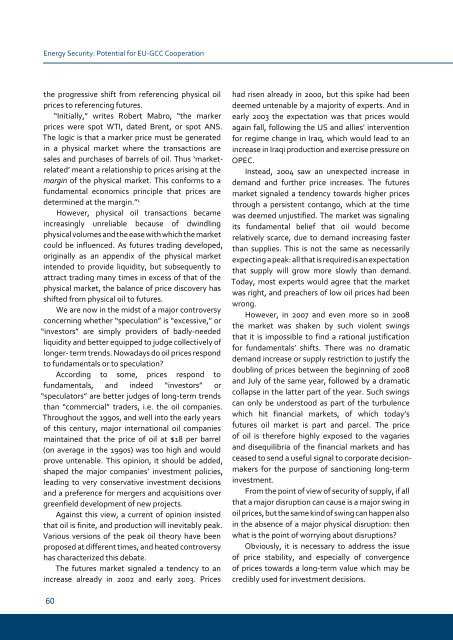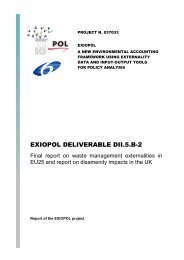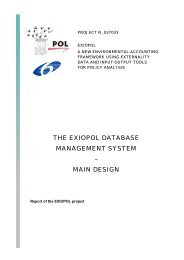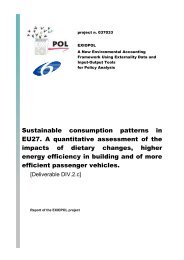Gulf and European Energy Supply Security - Feem-project.net
Gulf and European Energy Supply Security - Feem-project.net
Gulf and European Energy Supply Security - Feem-project.net
You also want an ePaper? Increase the reach of your titles
YUMPU automatically turns print PDFs into web optimized ePapers that Google loves.
<strong>Energy</strong> <strong>Security</strong>: Potential for EU-GCC Cooperation<br />
the progressive shift from referencing physical oil<br />
prices to referencing futures.<br />
“Initially,” writes Robert Mabro, “the marker<br />
prices were spot WTI, dated Brent, or spot ANS.<br />
The logic is that a marker price must be generated<br />
in a physical market where the transactions are<br />
sales <strong>and</strong> purchases of barrels of oil. Thus ‘marketrelated’<br />
meant a relationship to prices arising at the<br />
margin of the physical market. This conforms to a<br />
fundamental economics principle that prices are<br />
determined at the margin.” 1<br />
However, physical oil transactions became<br />
increasingly unreliable because of dwindling<br />
physical volumes <strong>and</strong> the ease with which the market<br />
could be influenced. As futures trading developed,<br />
originally as an appendix of the physical market<br />
intended to provide liquidity, but subsequently to<br />
attract trading many times in excess of that of the<br />
physical market, the balance of price discovery has<br />
shifted from physical oil to futures.<br />
We are now in the midst of a major controversy<br />
concerning whether “speculation” is “excessive,” or<br />
“investors” are simply providers of badly-needed<br />
liquidity <strong>and</strong> better equipped to judge collectively of<br />
longer- term trends. Nowadays do oil prices respond<br />
to fundamentals or to speculation?<br />
According to some, prices respond to<br />
fundamentals, <strong>and</strong> indeed “investors” or<br />
“speculators” are better judges of long-term trends<br />
than “commercial” traders, i.e. the oil companies.<br />
Throughout the 1990s, <strong>and</strong> well into the early years<br />
of this century, major international oil companies<br />
maintained that the price of oil at $18 per barrel<br />
(on average in the 1990s) was too high <strong>and</strong> would<br />
prove untenable. This opinion, it should be added,<br />
shaped the major companies’ investment policies,<br />
leading to very conservative investment decisions<br />
<strong>and</strong> a preference for mergers <strong>and</strong> acquisitions over<br />
greenfield development of new <strong>project</strong>s.<br />
Against this view, a current of opinion insisted<br />
that oil is finite, <strong>and</strong> production will inevitably peak.<br />
Various versions of the peak oil theory have been<br />
proposed at different times, <strong>and</strong> heated controversy<br />
has characterized this debate.<br />
The futures market signaled a tendency to an<br />
increase already in 2002 <strong>and</strong> early 2003. Prices<br />
0<br />
had risen already in 2000, but this spike had been<br />
deemed untenable by a majority of experts. And in<br />
early 2003 the expectation was that prices would<br />
again fall, following the US <strong>and</strong> allies’ intervention<br />
for regime change in Iraq, which would lead to an<br />
increase in Iraqi production <strong>and</strong> exercise pressure on<br />
OPEC.<br />
Instead, 2004 saw an unexpected increase in<br />
dem<strong>and</strong> <strong>and</strong> further price increases. The futures<br />
market signaled a tendency towards higher prices<br />
through a persistent contango, which at the time<br />
was deemed unjustified. The market was signaling<br />
its fundamental belief that oil would become<br />
relatively scarce, due to dem<strong>and</strong> increasing faster<br />
than supplies. This is not the same as necessarily<br />
expecting a peak: all that is required is an expectation<br />
that supply will grow more slowly than dem<strong>and</strong>.<br />
Today, most experts would agree that the market<br />
was right, <strong>and</strong> preachers of low oil prices had been<br />
wrong.<br />
However, in 2007 <strong>and</strong> even more so in 2008<br />
the market was shaken by such violent swings<br />
that it is impossible to find a rational justification<br />
for fundamentals’ shifts. There was no dramatic<br />
dem<strong>and</strong> increase or supply restriction to justify the<br />
doubling of prices between the beginning of 2008<br />
<strong>and</strong> July of the same year, followed by a dramatic<br />
collapse in the latter part of the year. Such swings<br />
can only be understood as part of the turbulence<br />
which hit financial markets, of which today’s<br />
futures oil market is part <strong>and</strong> parcel. The price<br />
of oil is therefore highly exposed to the vagaries<br />
<strong>and</strong> disequilibria of the financial markets <strong>and</strong> has<br />
ceased to send a useful signal to corporate decisionmakers<br />
for the purpose of sanctioning long-term<br />
investment.<br />
From the point of view of security of supply, if all<br />
that a major disruption can cause is a major swing in<br />
oil prices, but the same kind of swing can happen also<br />
in the absence of a major physical disruption: then<br />
what is the point of worrying about disruptions?<br />
Obviously, it is necessary to address the issue<br />
of price stability, <strong>and</strong> especially of convergence<br />
of prices towards a long-term value which may be<br />
credibly used for investment decisions.
















